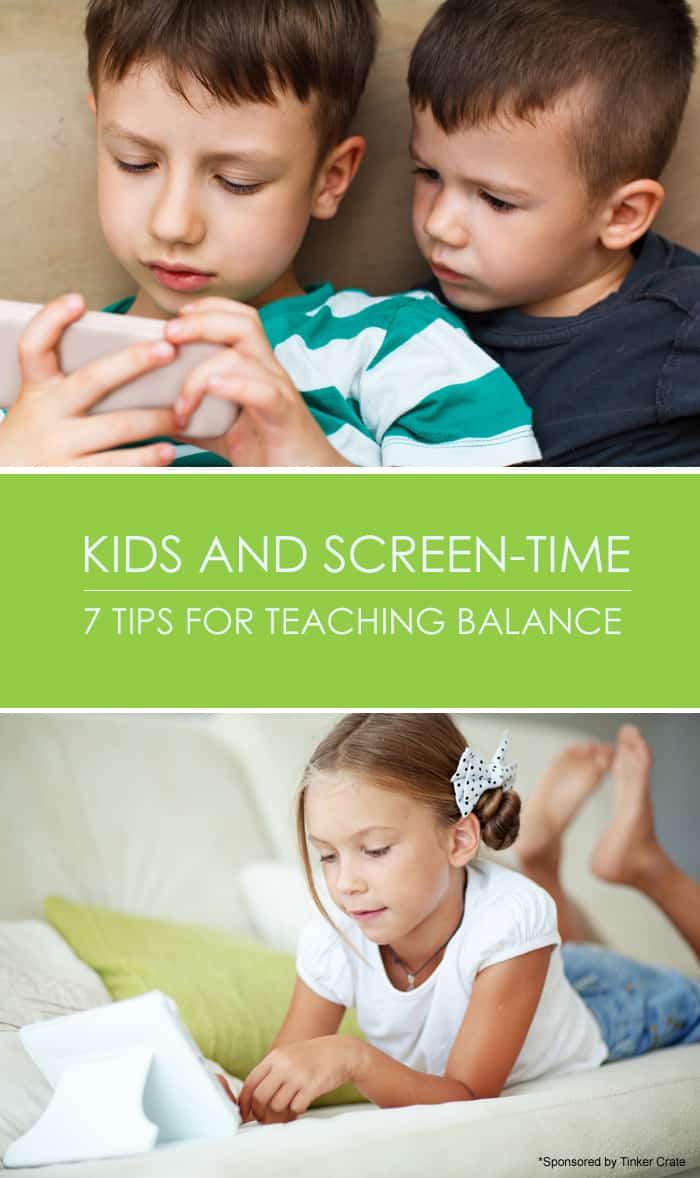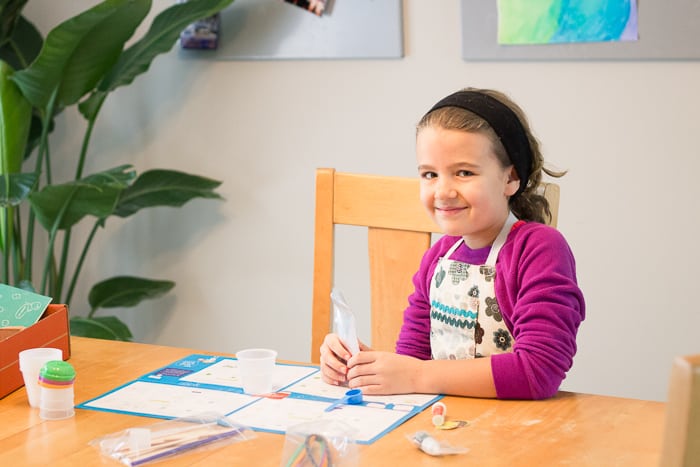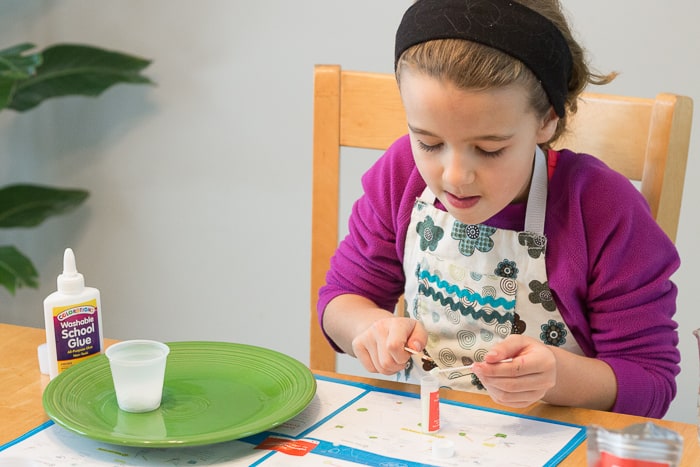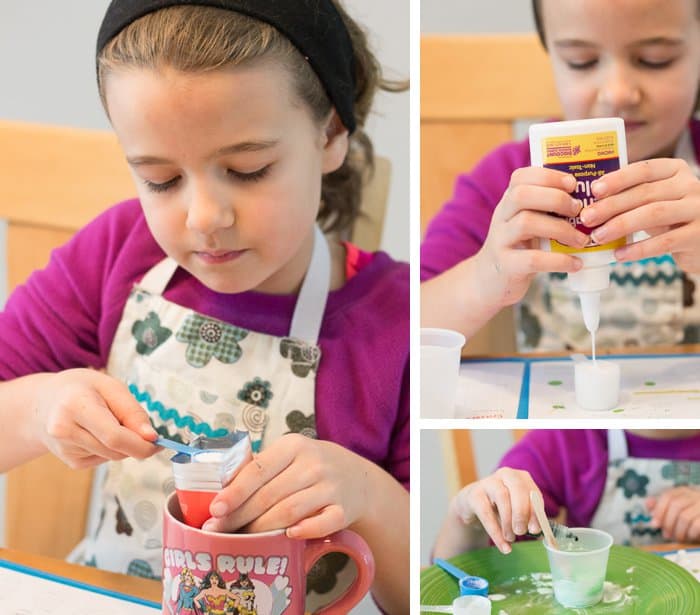Technology can be addictive. When my children pick up a device they become completely zoned-out. Do you find yourself arguing with your kids over video games, the tablet or TV?
Dealing with kids and screen-time can sometimes feel like a challenge because we have little parenting example to follow from our childhood. This topic has become an ongoing parenting discussion at our house.
7 Tips for Teaching a Healthy Family Balance
Here are seven inspiring screen-time tips:
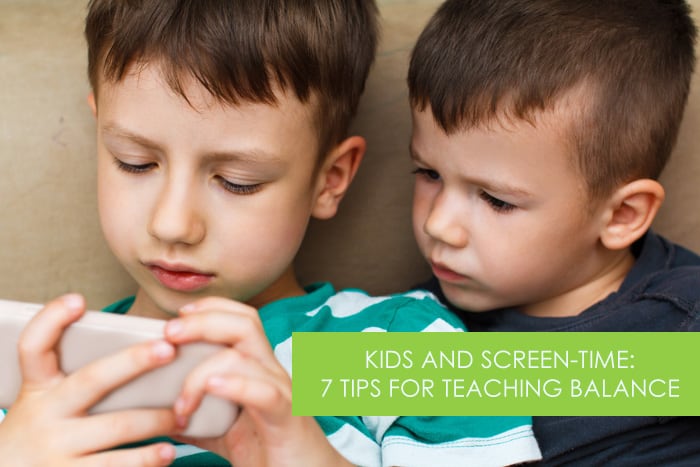
1. Set a daily limit.
Check out this brilliant, but simple suggestion from Sports Mom. She writes. "These sweet boys are surrounded by electronics that are hurting their minds, crushing their creativity and killing their social skills. Really, it’s just so easy to pick up an electronic. It takes no thought. It takes no effort. I decided to revert back to a system I used when the kids were little: Electronic Tickets." Read the full post. She offers her boys an hour of screen-time a day. Loved the post.
2. Or don't set a limit, set a barter system.
You know your child better than anyone. Sometimes setting a limit on something makes things even more attractive to a child. At our house, we trade 15-minutes of reading for 30-minutes of screen time. The reading is required BEFORE the screen-time and there is no limit on how much you can read. This simple approach has helped our family create a good technology balance.
![]()
Tired of the yelling? Tired of the whining? Tired of being tired?
You’re not alone. From toddler temper-tantrums to tweens talking back … how do we get our kids to cooperate?
One of my ongoing goals is to continue to work on having parenting tools in my pocket for these type of stressful parenting situations.
Which is why I am excited to be partnering with affiliate Amy McCready, founder of Positive Parenting Solutions & TODAY Show contributor, who offers FREE LIVE training affiliate webinars. You’re in luck. There is another webinar this month!
Get the next available date here: Upcoming Webinars
If you’re tired of nagging, reminding and yelling to get kids to listen – this session is for you.
 Discover proven tools for your most frustrating discipline dilemmas including the 5 R’s of Fair & Effective Consequences. This hour-long investment will leave you with ideas you can start using the SAME day.
Discover proven tools for your most frustrating discipline dilemmas including the 5 R’s of Fair & Effective Consequences. This hour-long investment will leave you with ideas you can start using the SAME day.
All you need is your computer. (No webcam required.) You’ll see and hear Amy on your screen and you can even ask questions and she’ll make them part of the presentation.
Webinar seating will be limited so learn more and RSVP now!
![]()
3. Define what 'technology' means.
Before you put any limitations on technology, you need to ask yourself, "Does that include TV time? Does it include playing games on the wii when the kids are up and active? If you do include TV time, does that include a movie that you are watching together as a family?" Be sure to have a clear definition before putting solutions into action. Check out this post from One Creative Mommy, she uses a technology token system with her children. Read the full post.
4. Create a list of unplugged activities.
"Life today is NOT the same as it was 30 years ago. Now, we have computers, tablets, smartphones, iPods and plenty of other devices to keep us busy 24/7. As useful as all these devices can be, they have a tendency to draw us into an unrealistic world and take us away from what is most important in life. I personally don’t feel like I need to eliminate technology in my home, I just need to limit screen time and find a healthy balance."
5. Carry an ACE in your pocket.
I agree that offering your kids awesome activities is a great way to inspire them to be screen-free, yet sometimes it feels unrealistic. We don't always have time to walk our kids to the park or go bowling.
I admit, screen time is an easy default when you feel like you're going to hit that breaking point. You know what I mean, right? That moment when you simply need 20 minutes to yourself to finish a project, get dinner started… find your sanity.
This is when I grab the ACE from my pocket: a little orange box hidden in the pantry. When our Tinker Crates come in the mail I hide them from the girls. I stash it away as a “Plan B” knowing that within the orange crate is EVERYTHING needed to entertain my daughter — all organized neatly within it. (AKA: no searching frantically around the house for pipe cleaners, glue sticks, or scissors.)
You’d think the smile captured below is what would make me *love* Tinker Crate, but it’s not.
THIS is the face that wins me over time and time again: She does this sweet thing with her lip when she is concentrating and enjoying herself.
We got out theTinker Crate and THIS is what I heard for the next 45-minutes:
Silence.
I needed 20 minutes to find my sanity. Tinker Crate scored me 45.
My girls think Tinker Crate ROCKS, but there are a variety of options available to match your child's age and personality:
- Tinker Crates are geared for kids age 9-14+ who enjoy hands-on science, technology, and engineering exploration. Pop over to their site to peek inside one of the crates.
- If your child is more crafty, check out Doodle Crates. These DIY project crates are geared towards kids 9-16+. Check out some of the current DIY tween projects.
- If you've got a little one on your hands, check out Kiwi Crate (ages 4-8) and Koala Crate (ages 3-4). We started with Kiwi Crates when the girls were younger and loved them.
Having a ready-to-go crate on-hand is a perfect alternative to screen time in a pinch.
6. Take a look at your own habits.
"When’s the last time you left your phone somewhere? How long did it take you to realize you were off the grid? If you’re like most of us, it took all of five minutes tops, right? And the panic that ensued as a result probably caused more than a little discomfort. We live in a hyper-connected, hyper-digital world, and our phones have—little by little—become the center of our universe."
7. Set standards for the future.
We need to remind ourselves, "I am a role model for my child when it comes to technology." When using your smart phone, keep this in mind. For example, if you don't want your child to turn into a teen who checks text messages while you are speaking to them, be sure YOU don't check text messages when your child is talking to you.
Look at your behaviors and ask yourself, do I want my child to do this when they are a teen? How often are you checking Facebook during the day? If you get a text during dinner, do you continue your conversation with your family or stop to see what it says? Don't accidentally put yourself in the category of — Do as I say, not as I do.
In the end, I think it is also important to remember that technology is not going away. There are so many articles out there about how to "limit" your child's screen-time. In my opinion, those types of articles often miss the mark. Really, when we are talking about kids and screen-time the discussion needs to be, how do we teach our kids to find a healthy balance?
How do you do find balance at YOUR house? I'd love to chat in the comments.

 |
 |
 |
 |
 |
|
 |
|||||
Disclosure of Material Connection:This is a “sponsored post.” The company who sponsored it compensated me via a cash payment, gift, or something else of value to write it. Some of the links in the post above are “affiliate links.” This means if you click on the link and purchase the item, I will receive an affiliate commission. Regardless, I only recommend products or services I use personally and believe will add value to my readers. I am disclosing this in accordance with the Federal Trade Commission’s16 CFR, Part 255: “Guides Concerning the Use of Endorsements and Testimonials in Advertising.”
![]()
Pin it:
